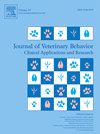Turn the volume down: Noise hypersensitivity in dogs
IF 1.3
3区 农林科学
Q4 BEHAVIORAL SCIENCES
Journal of Veterinary Behavior-clinical Applications and Research
Pub Date : 2025-05-01
DOI:10.1016/j.jveb.2025.04.005
引用次数: 0
Abstract
It is commonly reported that many companion dogs are sensitive to sudden, loud noises (e.g., fireworks, thunderstorms). However, reactivities and sensitivities towards other noises in a dog’s home and environment are not well understood. This study aimed to further investigate the types of noises that evoke a negative reaction in dogs and the associated risk factors. An online survey was circulated globally through social media platforms and veterinary clinics. The survey consisted of demographic information, measures (0–100 scale) for responses to Aversive Sounds (AS; e.g., fireworks), Human Sounds (HS; e.g., coughing), and Environmental Sounds (ES; e.g., vacuum cleaner). Descriptive analyses and general linear models were conducted to determine factors associated with reactions to the different sound categories. Dogs had a significantly higher reaction score toward AS and ES compared to HS. Dogs with anxiety and of an older age showed stronger reactions towards AS. Dogs owned by females, by owners aged 65+, and dogs with anxiety showed stronger reactions to ES. No factors were associated with reaction to HS. Some guardians reported their dogs reacted at a level of 100 (scale of 0–100 where 100 is most severe) to everyday sounds, such as vacuum cleaners and coughing, suggesting significant negative effects on their welfare. Understanding the types of everyday sounds that dogs are fearful of as well as the risk factors that contribute to them can help owners improve the welfare of their dogs, as well as strengthen the human-animal bond.
调低音量:狗狗对噪音过敏
据普遍报道,许多陪伴犬对突然的、巨大的噪音(如烟花、雷雨)很敏感。然而,对狗在家里和环境中对其他噪音的反应和敏感性还不是很清楚。这项研究旨在进一步调查引起狗狗消极反应的噪音类型以及相关的风险因素。一项在线调查通过社交媒体平台和兽医诊所在全球范围内传播。该调查包括人口统计信息,对厌恶声音(AS)的反应的测量(0-100分);例如,烟花),人声(HS;例如,咳嗽)和环境声音(ES;例如,真空吸尘器)。进行描述性分析和一般线性模型,以确定对不同声音类别的反应相关的因素。狗对AS和ES的反应得分明显高于HS。焦虑的狗和年龄较大的狗对AS的反应更强烈。女性养的狗、65岁以上的狗和焦虑的狗对ES的反应更强烈。没有与HS反应相关的因素。一些监护人报告说,他们的狗对吸尘器和咳嗽等日常声音的反应达到了100分(0-100分,100分是最严重的),这表明它们的福利受到了严重的负面影响。了解狗害怕的日常声音类型以及导致这些声音的风险因素可以帮助主人改善狗的福利,并加强人与动物的联系。
本文章由计算机程序翻译,如有差异,请以英文原文为准。
求助全文
约1分钟内获得全文
求助全文
来源期刊
CiteScore
3.50
自引率
16.70%
发文量
107
审稿时长
325 days
期刊介绍:
Journal of Veterinary Behavior: Clinical Applications and Research is an international journal that focuses on all aspects of veterinary behavioral medicine, with a particular emphasis on clinical applications and research. Articles cover such topics as basic research involving normal signaling or social behaviors, welfare and/or housing issues, molecular or quantitative genetics, and applied behavioral issues (eg, working dogs) that may have implications for clinical interest or assessment.
JVEB is the official journal of the Australian Veterinary Behaviour Interest Group, the British Veterinary Behaviour Association, Gesellschaft fr Tierverhaltensmedizin und Therapie, the International Working Dog Breeding Association, the Pet Professional Guild, the Association Veterinaire Suisse pour la Medecine Comportementale, and The American Veterinary Society of Animal Behavior.

 求助内容:
求助内容: 应助结果提醒方式:
应助结果提醒方式:


